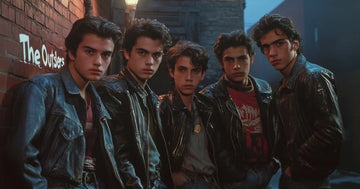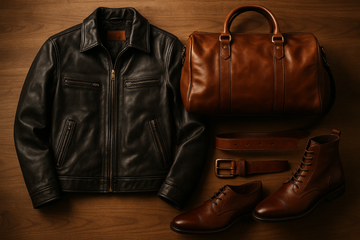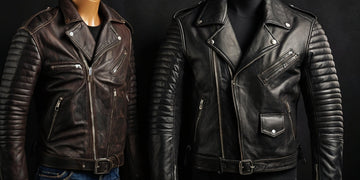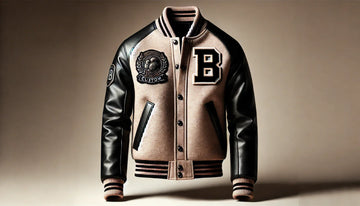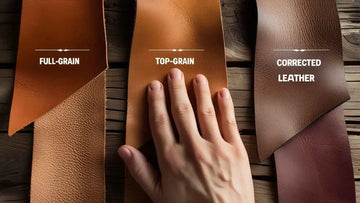Introduction: Why Your Leather Jacket Gets Better With Age
Leather jackets have always been a symbol of style, rebellion, and sophistication. However, over time, they seem to develop a unique charm that makes them even more desirable. The phrase "Why Your Leather Jacket Gets Better With Age" speaks to the growing appreciation of a well-worn jacket as it evolves into something personal and unique. As the leather softens and adapts, it becomes more than just a garment—it transforms into a reflection of the wearer’s journey.
In this post, we will delve into the reasons why leather jackets get better with age, shedding light on their timeless appeal, the benefits of wearing them regularly, and how they evolve with use. You’ll also learn why the worn-in look is coveted by fashion enthusiasts and how it becomes a signature of quality craftsmanship.
-
Leather is a natural material that responds beautifully to wear.
-
The patina that develops over time makes each jacket unique.
The Science Behind Leather Aging
Leather is a natural material, often derived from animal hides, which makes it prone to undergoing a transformation as it ages. The fibers within the leather are constantly reacting to external elements like air, light, and moisture. These factors contribute to the development of a patina—the natural shine or luster that emerges as leather is worn.
As the leather absorbs oils from your skin, the surface becomes more supple and comfortable. This process not only enhances the jacket’s look but also its feel. Over time, the leather becomes more malleable, fitting the contours of your body in a way that mass-produced synthetic materials simply cannot.
The Patina Effect: A Badge of Character
One of the primary reasons leather jackets improve with age is the patina effect. Patina is a natural process that occurs as leather absorbs environmental elements, such as sunlight, rain, and body oils. Over time, these elements interact with the leather, creating a rich, multi-dimensional color that adds character to the jacket.
The patina process is highly individual, meaning that no two leather jackets will ever age in the same way. This gives each jacket a distinct personality, a quality that mass-produced garments simply cannot replicate. As your jacket wears in, it will tell the story of your adventures and experiences, making it truly one-of-a-kind.
The Comfort Factor: Breaking in Leather
New leather jackets often feel stiff and rigid, but with time and wear, the leather softens, molding to your body shape. This "breaking in" process is what makes an old leather jacket feel incredibly comfortable. The stiffness fades, and the jacket becomes more flexible, allowing for greater freedom of movement.
Many leather enthusiasts even seek out vintage or worn leather jackets for this very reason. The jacket already has the comfort of a well-worn piece, which means you don’t have to wait through the often uncomfortable break-in period. As a result, these jackets offer a blend of style and comfort that few other materials can match.
A Unique Aesthetic: Wear Marks and Distressing
As your leather jacket ages, it begins to develop wear marks and distressing. These marks aren’t signs of damage, but rather badges of honor that show the jacket’s journey. Scuffs, scratches, and creases become part of the jacket’s unique story. Whether caused by a fall, a scrape against a rough surface, or a simple folding of the fabric, these marks add depth and character.
This natural distressing is one of the reasons why pre-worn leather jackets are so desirable. The worn-in look suggests that the jacket has been loved and used, giving it an air of authenticity. In fact, many fashion-conscious individuals specifically seek out jackets with these qualities, as they are seen as a testament to durability and craftsmanship.
Durability: Built to Last
Leather is an incredibly durable material. Unlike many fabrics, it has the ability to stand up to wear and tear. This makes leather jackets not only long-lasting but also resistant to environmental elements like wind, rain, and cold. With proper care, a leather jacket can easily last for decades, only improving as it ages.
The longevity of a leather jacket is one of the key reasons why it gets better with age. While synthetic materials often degrade over time, leather only grows more beautiful and functional. It’s this quality that has kept leather jackets in high demand for generations, cementing their status as a timeless wardrobe staple.
Why Vintage Leather is So Coveted
Vintage leather jackets are some of the most highly sought-after garments in fashion. The charm of a well-aged leather jacket cannot be matched by new items, making them a valuable find for fashion collectors and enthusiasts. The unique patina, comfort, and distinct features of vintage leather jackets contribute to their appeal.
In addition to the patina and wear marks, vintage leather jackets often showcase high-quality craftsmanship that is becoming increasingly rare in modern mass-produced goods. Many vintage leather jackets were made by hand, using techniques that prioritize durability and attention to detail. As a result, they offer a level of quality that contemporary jackets may lack.
The Emotional Connection
Leather jackets often hold emotional significance for their owners. Over time, they become more than just a piece of clothing—they become a part of the wearer’s identity. Whether the jacket has been worn during memorable events or simply serves as a constant companion on everyday adventures, the connection between the wearer and the jacket strengthens over the years.
As your leather jacket ages, it becomes a physical representation of your experiences. The more you wear it, the more the jacket reflects your personal style and memories. This emotional connection is part of what makes leather jackets so special, as they grow alongside the wearer and carry sentimental value.
Caring for Your Leather Jacket
To ensure your leather jacket ages gracefully, proper care is essential. Regular cleaning, conditioning, and storage can help maintain the leather’s texture and prevent damage. It’s important to keep the jacket in a cool, dry place, away from direct sunlight, to avoid fading. Additionally, using leather conditioners helps replenish the oils that the jacket loses over time, keeping it soft and supple.
When it comes to cleaning, always use a gentle cleaner designed for leather. Harsh chemicals can strip away the natural oils, causing the leather to dry out and crack. Regularly brushing the jacket with a soft cloth can help remove dirt and debris, ensuring the leather remains in top condition.
The Timeless Appeal of Leather
There’s no denying the timeless appeal of leather. Whether you’re wearing a classic biker jacket, a tailored bomber, or a sleek blazer, leather exudes an aura of sophistication and confidence. The more you wear your leather jacket, the more it embodies your personal style, making it a true wardrobe investment.
In a world where trends come and go, leather remains a constant. Its durability, comfort, and aesthetic appeal ensure that it never goes out of style. As your leather jacket ages, it becomes an even more important part of your wardrobe, transcending fleeting fashion fads and becoming a staple that stands the test of time.
Conclusion: Embrace the Worn-In Look
Ultimately, the reason why your leather jacket gets better with age is that it becomes more than just an item of clothing. It becomes a testament to the passage of time, a reflection of your journey, and a symbol of enduring style. Whether it’s the softening of the leather, the unique patina, or the emotional connection you form with the jacket, every aspect of its aging process contributes to its timeless appeal.
Embrace the worn-in look and let your leather jacket evolve alongside you. With every passing year, it will only become more beautiful, comfortable, and meaningful.
FAQs About Leather Jackets and Why They Get Better With Age
1. How long does it take for a leather jacket to break in?
The time it takes for a leather jacket to break in varies depending on the type of leather and how often it's worn. Typically, it can take anywhere from a few weeks to several months for the leather to soften and mold to your body. Regular wear, especially in cooler climates, speeds up the process.
2. What is patina, and why is it important for a leather jacket?
Patina refers to the natural sheen or surface appearance that develops on leather over time. It’s caused by exposure to light, air, oils from your skin, and environmental elements. The development of patina gives the jacket a unique, aged look and is highly valued by leather enthusiasts, as it adds character and individuality.
3. Can I speed up the aging process of my leather jacket?
While you can’t rush the natural aging process, there are ways to help leather soften and develop its patina more quickly. Wearing it frequently and storing it properly in a dry, cool place helps. Some people apply leather conditioners or oils to enhance the leather's texture and prevent it from drying out, though it's important to do this sparingly to avoid altering its appearance too much.
4. How do I prevent my leather jacket from cracking over time?
Proper care is key to preventing leather from cracking. Keep your jacket clean, condition it regularly with leather-friendly products, and avoid exposing it to harsh sunlight or extreme heat. Also, make sure to store it in a well-ventilated area to maintain its flexibility. Avoid hanging it in damp places, as moisture can lead to mold or mildew growth.
5. Is it normal for a leather jacket to change color over time?
Yes, it’s completely normal for leather jackets to change color as they age. This is part of the patina process, where the leather absorbs oils, dirt, and sunlight, gradually darkening or lightening in certain areas. Some jackets may even develop a slightly more vintage, worn look with different shades across the surface, making them truly one-of-a-kind.
6. What’s the best way to clean my leather jacket?
To clean your leather jacket, use a soft, damp cloth to wipe away surface dirt. For deeper cleaning, use a mild leather cleaner or soap specifically made for leather. Avoid using harsh chemicals or abrasive materials, as these can damage the surface. After cleaning, apply a leather conditioner to restore moisture and maintain its suppleness.
7. Can leather jackets be repaired if damaged?
Yes, leather jackets can often be repaired if they’re damaged. Small scratches or tears can be patched up with leather repair kits, while larger damage may require professional restoration. The beauty of leather is that, even after repairs, it still retains its charm and can continue to age naturally.
8. Why do some people prefer vintage leather jackets over new ones?
Vintage leather jackets are often preferred because they have already gone through the breaking-in process and developed a unique patina. The craftsmanship of older jackets, typically made by hand, is also prized for its durability and attention to detail. Vintage jackets carry a story, which adds to their appeal, making them feel more personal and distinctive compared to new ones.
9. Can I wear my leather jacket in the rain?
Leather is somewhat water-resistant, but prolonged exposure to rain can damage the material over time, especially if the jacket is not treated. If caught in the rain, gently blot the jacket with a soft cloth to remove excess moisture and allow it to dry naturally, away from direct heat sources. To improve water resistance, you can apply a waterproofing spray made for leather.
10. How can I store my leather jacket to maintain its shape?
To maintain the shape of your leather jacket, always store it on a padded hanger to prevent the shoulders from losing their structure. Avoid hanging it in damp or direct sunlight, as this can cause the leather to dry out or fade. You can also use a garment bag to protect it from dust while ensuring it stays in a well-ventilated area.
11. Is there a specific type of leather that ages better than others?
Full-grain leather is known to age the best, developing the most distinctive patina over time. It’s made from the top layer of the hide, retaining all of the natural texture and markings. Other types of leather, like top-grain or bonded leather, may not age as beautifully or last as long. Full-grain leather is often the preferred choice for jackets that will be worn for many years.
12. Why do leather jackets feel more comfortable with time?
Leather becomes more comfortable over time because it softens and molds to the shape of your body. The natural oils in your skin help break in the leather, making it more flexible and less stiff. As the jacket becomes accustomed to your movements, it provides greater comfort without sacrificing its classic look.

